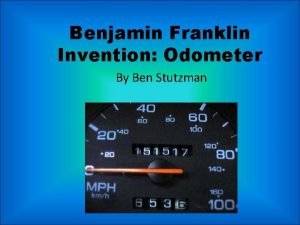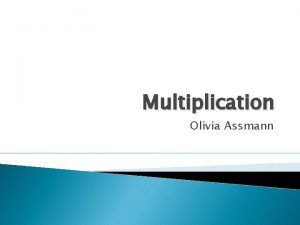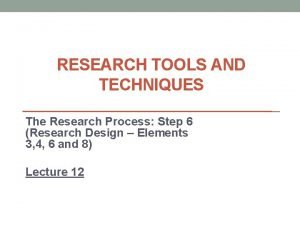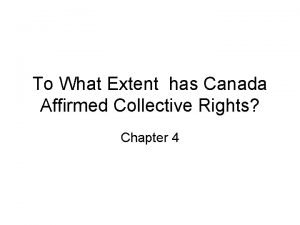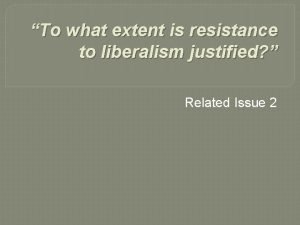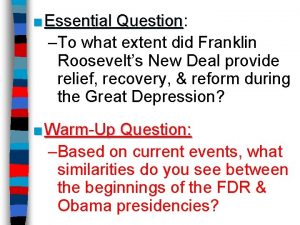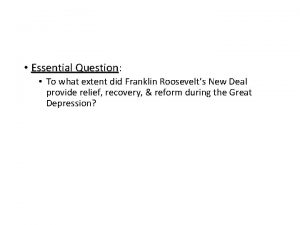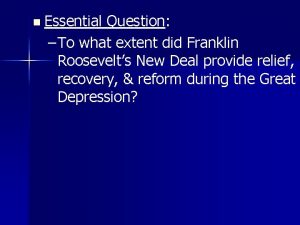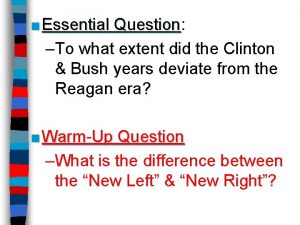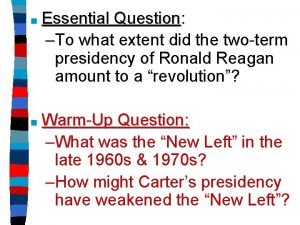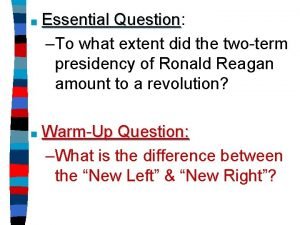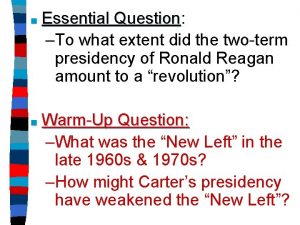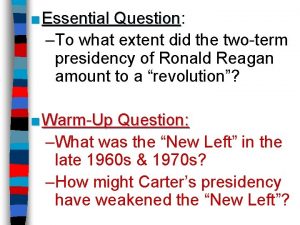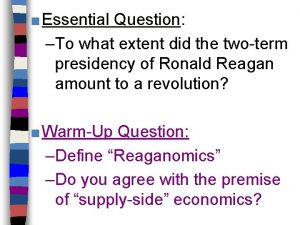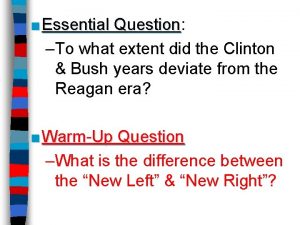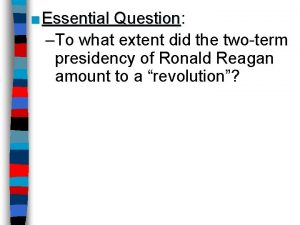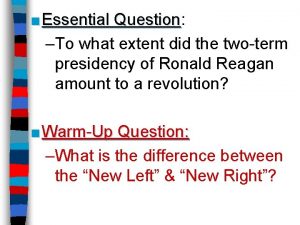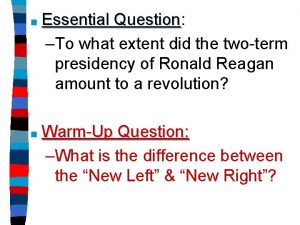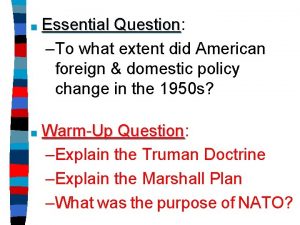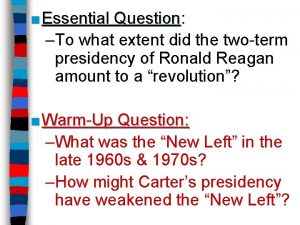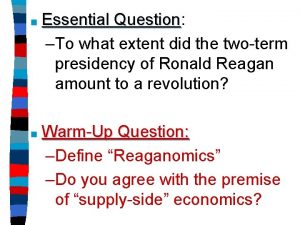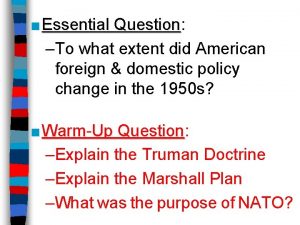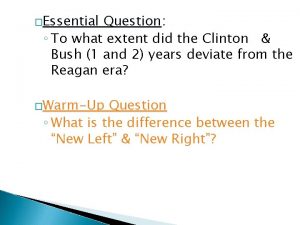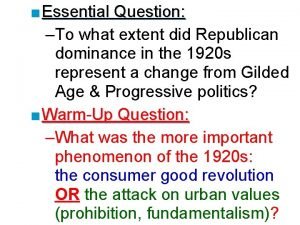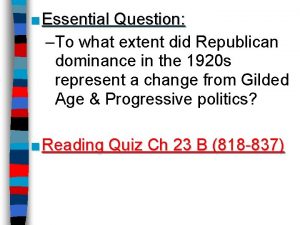Essential Question Question To what extent did Franklin


































- Slides: 34

■ Essential Question: Question –To what extent did Franklin Roosevelt’s New Deal provide relief, recovery, & reform during the Great Depression?

Franklin Roosevelt & the First New Deal (1933 -1935)

What was the New Deal A. Roosevelt’s program for economic recovery B. Three main goals 1. relief for the jobless 2. plans for economic recovery 3. reforms to prevent another depression. The President’s New Deal programs changed the relationship between government and the economy. From then on the federal government took an active role in managing the American Economy.

The Hundred Days ■ When FDR took over in 1933, the FDR for “broad power of U. S. asked economy wasexecutive on the brink that would be given to me if we were in collapse: fact invaded by a foreign foe. ” –Unemployment was at 25% – 38 states had total bank failure ■ FDR requested from Congress broad executive power to begin his “New Deal” program of economic relief, recovery & reform

“Let me assert my firm belief that the only thing we have to fear is fear itself; nameless, unreasoning, unjustified terror which paralyzes needed efforts to convert retreat into advance. ”

The Hundred Days st hundred Banks (notdays, nationalized); ■ In were his 1 regulated FDR Now, the FDIC insures the economic system was reformed st began up histo 1$250, 000 New Deal (1933 -35) deposits (not drastically changed) ■ FDR’s 1 st order of business was to Emergency Banking in Actbanking: of 1933 restore confidence –Declared a 4 -day bank holiday: closed or funded weak banks & opened new gov’t-aided banks –Glass-Steagall Act created the FDIC which guaranteed all bank deposits up to $5, 000

“Capitalism was saved in eight days”

The Hundred Days ■ The greatest success of the First New Deal was its ability to offer relief to unemployed citizens via the Reconstruction Finance Corps –Modest relief checks were doled to 15% of Americans –Federal Emergency Relief Act (FERA) pumped $500 million into state welfare programs

The Hundred Days ■ Relief efforts of the First New Deal created more “alphabet agencies” –Civilian Conservation Corps (CCC) employed urban men –Civilian Works Admin (CWA) hired 4 million men & women –Agricultural Adjustment Admin (AAA) subsidized farmers

CCC workers paved roads, planted trees, built bridges

CWA Creating drainage system for an airfield Dredging a lake

AAA

Percentage of American Families Accepting Government Relief in 1933

The Hundred Days ■ The National Industrial Recovery Act (NIRA) was the 1 st attempt at economic recovery: –Created the National Recovery Admin (NRA) set max hours & minimum wages for workers & stimulated industry by fixing prices & setting production limits Additional attempts to stimulate the economy Works Admin include–Created taking the U. S. Public off the gold standard & st amendment) ending prohibition (21 public (PWA) to build roads, bridges, & buildings

National Recovery Administration The NRA ended up being too bureaucratic; business cooperation gave way to self-interest & greed

The Hundred Days ■ Some of FDR’s First New Deal focused on long-term reforms –Tennessee Valley Authority (TVA) created dams in 7 states to provide cheap hydroelectric power & create jobs –Securities & Exchange Commission (SEC) to regulate the stock market & prevent another stock market crash

The Tennessee Valley Authority Critics claimed the TVA was too socialistic; Competing electric companies attacked the TVA for selling cheaper electricity & eliminating competition

The Hundred Days ■ The 1 st hundred days of FDR’s administration were temporary solutions to solve problems, but… ■ …psychologically, Americans believed that FDR was actively responding to the Great Depression

The Hundred Days “The whole country is with him, just so he the hand an irondown dictator does“Even something. If heofburned the is in preference to a and paralytic stroke” capitol we would cheer say ‘well, we —Alf (Repub nominee in 1936) at least got. Landon a fire started anyhow. ’” —Will Rogers

Franklin Roosevelt & the Second New Deal (1935 -1938)

Criticism of the First New Deal ■ The failure of the New Deal to end the depression led to growing frustration among Americans –From 1933 -1934, the New Deal focused in immediate problems & did very little to help unskilled workers & sharecroppers –In 1935, FDR shifted approach from economic relief to reform

Challenges to FDR ■ By 1935, signs of discontent with the New Deal were evidenced as 3 critics gained national attention: –Father Charles Coughlin called for nationalizing U. S. banks; used anti-Semitism in radio sermons –Francis Townsend appealed to the elderly with a $200/mo payment plan to anyone over 60 in order to stimulate the economy

Father Charles Coughlin

Dr. Francis Townsend

Challenges to FDR ■ Louisiana Senator Huey Long proposed his Share the Wealth plan to: –Take from the rich— a 100% tax on all personal income over $1 million –Give to the poor— give every citizen $2, 500 per year “The Kingfish”

The Second New Deal ■ The 1 st act of the 2 nd New Deal was WPA helped but never employed enough Works (WPA), the (WPA) people. Progress to stimulate. Admin consumer purchase most comprehensive, direct-bearable power—it made the Depression assistance program of the New Deal –The Fed gov’t hired 10 million in attempt to stimulate the economy. Pay was double of welfare. –WPA created building projects, funded artists, & pumped $10 billion into the economy

WPAcared Public Work Project WPA less about what got done as long as work was done: built hospitals, schools, airport fields… but also moved leaf piles & dug ditches

Court Packing ■ 1935: 1935 Supreme Court declares NIRA unconstitutional and AAA in 1936, then 8 other ND laws. – FDR not happy. Wants to add six justices who will be on his side. – Blocked b/c thought would unbalance separation of powers. – Worked b/c SC stopped blocking


Social Security ■ Social Security Act (1935) was the 1 st U. S. welfare program for the aged, disabled, & unemployed –Old-age pensions to be funded by employers & workers –Unemployment compensation to begin in 1942 funded nat’l taxes but administered by states –Welfare payments for the blind, handicapped, & needy children

■ Liberal critics argued that SS did not do enough ■ Conservative critics argued that SS violated individualism & self -reliance ■ Social Security created America’s 1 st welfare program to help individuals

Labor Legislation ■ Wagner Act (1935) created the Nat’l Labor Relations Board to oversee labor-management affairs –Mandated management The “Magna Carta” for labor to negotiate with unions regarding 40 hours pay, hours, conditions if majority per week 40¢ per hour of workers vote for a union ■ Fair Labor Standards Act (1938) created 1 st minimum wage & maximum hour laws (aimed at helping non-unionized workers)

Success of the New Deal Programs?

The gov’t assumed For the 1 st time, the Conclusions gov’t used Keynesian responsibility for the ■ The New Deal was of 3 healthmade of the up nation's economics (deficit economy&&reform citizens spending gov’t recovery, parts: &relief, relief recovery spending to stimulate The New Deal signaled – New Deal was most successful the economy) the beginning of the in providing immediate relief to welfare state ease economic suffering –The New Deal did not bring economic recovery or an end to the depression –The New Deal brought major reforms that changed America
 Essential non essential fatty acids
Essential non essential fatty acids Benjamin franklin
Benjamin franklin Level 2 question
Level 2 question Figurative language essential questions
Figurative language essential questions Formula hipotenusa triangle rectangle
Formula hipotenusa triangle rectangle Essential question generator
Essential question generator Essential questions for pythagorean theorem
Essential questions for pythagorean theorem Essential question for figurative language
Essential question for figurative language Essential question about identity
Essential question about identity Essential context clues
Essential context clues What is the essential question in cornell notes
What is the essential question in cornell notes What makes a question essential
What makes a question essential Essential question for multiplication
Essential question for multiplication Essential question gif
Essential question gif Essential questions for character traits
Essential questions for character traits What is the cornell way
What is the cornell way Essential questions for short story unit
Essential questions for short story unit To what extent has canada affirmed collective rights
To what extent has canada affirmed collective rights Was the british empire the biggest
Was the british empire the biggest Contrived and non contrived study setting
Contrived and non contrived study setting Table of extent 0
Table of extent 0 Nature and extent of juvenile delinquency
Nature and extent of juvenile delinquency Face validity examples
Face validity examples To what extent should we embrace globalization
To what extent should we embrace globalization Should internationalism be pursued
Should internationalism be pursued To what extent has canada affirmed collective rights
To what extent has canada affirmed collective rights Should nation be the foundation of identity
Should nation be the foundation of identity How to answer to what extent questions apush
How to answer to what extent questions apush To what extent should we embrace nationalism
To what extent should we embrace nationalism To what extent is resistance to liberalism justified
To what extent is resistance to liberalism justified Which bird can rotate its neck backwards to a large extent
Which bird can rotate its neck backwards to a large extent Beowulf study questions
Beowulf study questions Extent of researcher interference
Extent of researcher interference How do neurotransmitters influence behavior
How do neurotransmitters influence behavior To what extent adverbs
To what extent adverbs

